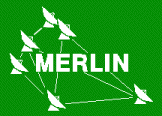
Newsletter

 |
Newsletter |
 |
| Number 2: March 2000 | ||||
| MERLIN | VLBI AT JBO | PROPOSALS | ARCHIVE | CONTACT |
| Contents | |
|
MERLIN will be offering all three standard frequencies for 00B (1.4/1.6 GHz, 5 GHz and 22 GHz). L-Band will be available at the start of the session. The timing of the change to C/K-Band will be determined by user demand and the MERLIN TAG's view of the proposed science. There will be only one change from L-Band to C/K-Band. It is planned to have a joint MERLIN + EVN session at L-Band in November 2000. Applications for such observing time should be submitted to the EVN (see below).
Proposal forms, information on MERLIN Key Programmes, and further general information can be obtained via:
| www: | http://www.merlin.ac.uk | ftp: | ftp.jb.man.ac.uk, Directory: /pub/merlin/proposals | email: | merlin@jb.man.ac.uk |
Potential users of the European VLBI Network should read the recent Announcement of Opportunity, which describes the award of a grant from the European Commission's Access to Research Infrastructure Programme. This grant is designed to support access to the EVN and is available to astronomers at EU (or Associated States) institutes that are not affiliated to the EVN institutes. More details can be obtained at:
As was mentioned in the September 1999 Newsletter, the National Facility will be reviewed this coming autumn. It has been decided to have a full International Review and the review panel will have broad terms of reference. The panel will consist of senior and respected radio astronomers from around the world.
Now to the good news - late last year it was announced that the University of Manchester had been successful in its application for about £ 2 million from the Joint Infrastructure Fund to upgrade the 76-m diameter Lovell Telescope. The upgrade will consist of the replacement of the telescope surface, a new control system and refurbishment of the track and foundations. The work will take place over the next three summers and should be complete by late 2002. Once completed the telescope is expected to have significant gain at 10 GHz. It will be a very welcome addition to MERLIN at 5 GHz and, when combined with upgrades of the MERLIN 5 GHz receivers (a project currently underway), will triple the sensitivity of the array at that frequency.
We welcome Barry Maguire to the National Facility staff as an aips++ programmer. Jodrell Bank was one of the founding members of the aips++ consortium. Unfortunately, due to constraints on resources, it was forced to withdraw from the consortium a few years ago. However, with the recent release of the first public version of aips++, it was felt that the National Facility and Jodrell Bank Observatory should be participating in the new generation of astronomical data processing software. Therefore, we have rejoined the consortium and hired Barry. His first job will be to ensure that MERLIN data can be read into aips++ and calibrated.
Following detection of the radio counterpart to the X-ray emission as a weak (<10 mJy) source on Oct 14 and 15, the rise, peak and decay of a bright radio flare event from the system was recorded on October 16 (Fig. 2). This is one of the clearest observations of a radio flare event from an X-ray binary ever made, in particular in its coverage of the rise, which is notoriously difficult to catch. It almost certainly corresponds to the ejection of a large mass of material from the system, probably at relativistic velocities. Ongoing observations of this exciting source with XTE, CGRO and at radio wavelengths with a host of ground-based observatories, including MERLIN, the VLA, GBI, RT and the EVN promise further insight into the relation between accretion and ejection in black hole binary systems. MERLIN observations of this source and those of others, such as GRS 1915+105 (Fender et al. 1999), are crucial in understanding the physics of such systems. Investigators: R.P. Fender (University of Amsterdam), C. Brocksopp (Open University), T.W.B. Muxlow, R.E. Spencer and S.T. Garrington (MERLIN/VLBI National Facility and Jodrell Bank Observatory), G.G. Pooley (University of Cambridge), H R.M. Hjellming (NRAO), A.M. Stirling (University of Central Lancashire).
Darnhall was selected as the first telescope to be changed. As reported in the previous Newsletter, the summer of 1999 saw all the original control equipment, motors and limit switches removed and replaced. At the same time, the opportunity was taken to install new distribution equipment along with power and lighting circuits in the pedestal room. All cabling on the site was examined and rationalised. Due to the retirement of the Electrical Workshop Supervisor, the installation of the cabling was placed with contractors. Our staff installed the motors and limit switches, and made the connections to the control computer.
Overall, the project went well. The shaft of the new motors was slightly longer than that of the old system and had to be modified but otherwise the motors were a direct replacement. The drives and control equipment for the new motors have behaved well since they have been installed although there are a small number of outstanding items that are still to be resolved. This work will be completed shortly. The control computer software has been significantly upgraded, as has the interface between the computer and the new system.
Darnhall is currently participating in the Semester 00A observations at 5 and 22 GHz and appears to be working well. Preparations have started for the changes to the remaining two telescopes this summer.
An announcement concerning the school was sent to various mailing lists, it proved so popular that within a week of the initial announcement it was oversubscribed. There will be 45 attendees in total, 16 from overseas. The agenda and other information is available at;
Sessions on basic data reduction will be given by National Facility and EVN staff and Jodrell Bank Observatory personnel. There will also be guest speakers who will discuss some of the science currently performed by MERLIN and the EVN and will also look towards the future. Guest speakers and their topics include: Karen Wills (Sheffield) on 'HI absorption'; Stewart Eyres (LJMU) on 'Novae: interpreting weak, variable structure'; Katherine Blundell (Oxford) on 'Radio galaxies: what are we looking for?'; Jeremy Yates (Herts) on 'High-frequency interferometry' and Rob Fender (Amsterdam) on 'X-ray counterparts and other faint variable sources'.
We thank the EVN for contributing to the travel costs of some delegates to this school through their EC programme 'Access to Large Scale Facilities: the European VLBI Network and JIVE'. We apologise to those who inquired about the school but were unable to get a place. We hope to make the lecture notes and model data reduction routines available after the school. Please visit the web site or contact us (Anita Richards: amsr@jb.man.ac.uk; Tom Muxlow: twbm@jb.man.ac.uk) if you are interested in obtaining them.
It is the policy of the MERLIN/VLBI National Facility that the investigators named on a MERLIN proposal have the sole right of access to the data obtained for that proposal for one year after the end of the Semester in which the observations were made. If the data are part of a programme with long-term status then the investigators have sole right of access to all the data of that programme for one year after the end of the Semester in which the final set of observations were made.
An astronomer wishing access to data from the archive after the period defined above should make a request in writing to the Director of the National Facility (pdiamond@jb.man.ac.uk). Under normal circumstances, the PI will be contacted to determine if there is a valid reason for an extension to the one-year time limit.
With the impending arrival of a web-based archive, the policy will be reviewed at the next meeting of the MERLIN/VLBI National Facility Steering Committee.
In the September 1999 Newsletter, the appointment of Dr. Anita Richards as the NF data archivist was announced. Anita's principal job is to generate an archive of calibrated data and images for all publicly accessible MERLIN data. This is a major task and the archive will be made available in stages as appropriate. As stated above the data access policy will be reviewed at the next meeting of the Steering Committee.
One immediate benefit to users is a new service that we are providing for rapid access to MERLIN data taken as part of joint MERLIN/EVN observations. We can provide the amplitude calibrated uv data in FITS format, suitable for imaging and combining with EVN data. This can usually be done on a timescale similar to the correlation of the EVN data; about half a dozen PIs have used this service to date, a slightly larger number preferring to visit Jodrell (or arrange for a co-worker to visit) to reduce the data from scratch. Please contact Anita (amsr@jb.man.ac.uk) concerning this particular service.
If you ever want to remove yourself from the MERLIN mailing list, send an email to Majordomo@jb.man.ac.uk with the following command in the body of the email message;
or from another account, besides the one used to subscribe to the list,
If you ever need to get in contact with the owner of the list, (if you have trouble unsubscribing, or have questions about the list itself) send email to owner-merlin-announce@jb.man.ac.uk.